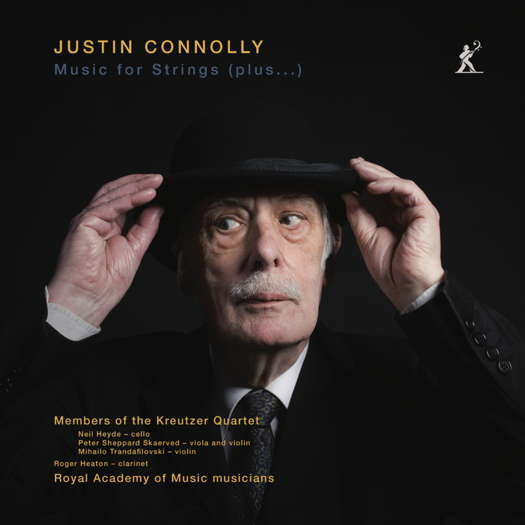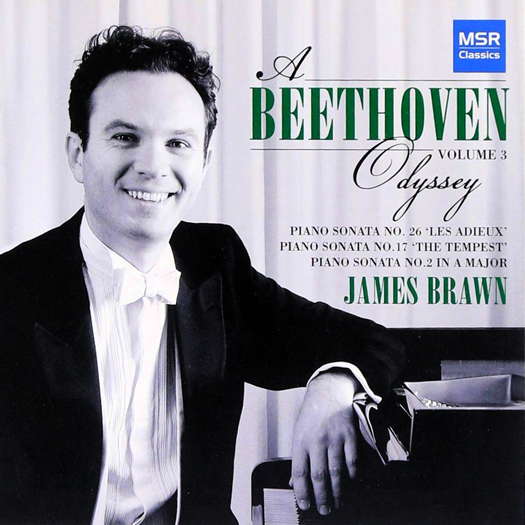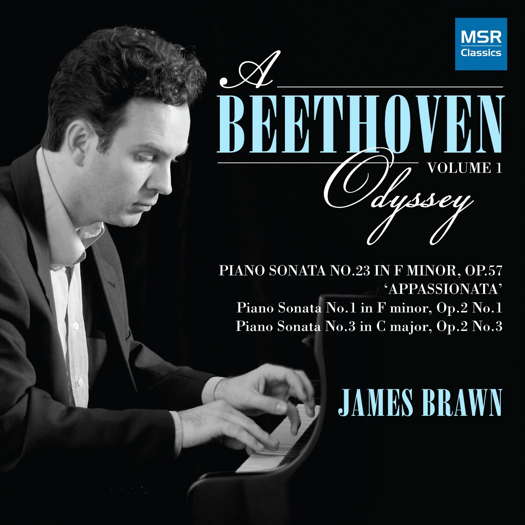- Michael Curtis Brewer
- Hans Wallat
- Chia-Ying Tu
- Guild Music
- John Sherwood de Lancie
- William Tell
- Nicholas Hersh
- George Franklin Coulouris

Contrasting Elements
GEOFF PEARCE gradually discovers the charm and skill of music by Justin Connolly
'... simply superb.'
I must profess to have never heard of the important British composer and teacher Justin Connolly (1933-2020). Some stellar musicians and orchestras have performed his music quite extensively and I think some of his works must have been performed here in Australia, but I am not aware of any such performances.
The first work on these discs is the String Trio, Op 43 (2009-10). Although this work was completed in 2010, in 2003 Justin Connolly had told Nicholas Hodges - the pianist he dedicated his piano concerto to - that he had started work on a trio, dedicated to Milton Babbitt (who was approaching ninety). The work is in three movements, the structure is classical and the music itself is evidently more conventional than much of his earlier music. The music is energetic and quite tense, and the performers are treated in a soloistic manner, with the viola often introducing new ideas and solos. There are also some surprisingly warm and almost lyrical passages. This was the composer's last major work and received its premiere in February 2024, with the same performers as on this recording, drawn from the Kreutzer Quartet - Mihailo Trandafilovski, Peter Sheppard Skærved and Neil Heyde.
Listen — Justin Connolly: Calmo ed espressivo (String Trio, Op 43)
(MEX 77209 CD1 track 2, 0:00-0:57) ℗ 2025 Divine Art Ltd :
Tesserae C, Op 15/III, for solo cello, in five short movements, was written in 1971 for a cellist I have great fondness for - Ralph Kirschbaum - and performed by Kirschbaum later that year. To quote the composer's programme notes in this booklet:
Tesserae are the constituent parts of a mosaic, or the counters used in Greco-Roman games of chance, mere fragments of material lacking any significance in themselves but acquiring it by the use to which they are put. For the background material, the composer uses an Anglican hymn tune that makes an appearance in Hubert Parry's opera Judith.
The writing is interesting and varied, and although quite radical, does not alienate me, and I am very impressed with the skill and commitment of the cellist, Neil Heyde.
Listen — Justin Connolly: Alla burlesca (Tesserae C, Op 15/III)
(MEX 77209 CD1 track 7, 1:33-2:22) ℗ 2025 Divine Art Ltd :
Also from 1971 is Triad V, Op 19. Again, the notes from the composer are most helpful in outlining the origins and structure of the work. It is part of a series of three movement works that began in 1964. The performers on this disc are Emily Su, violin, Dmytro Fonariuk, clarinet and Neil Heyde, cello. The work is generally slow but there are quicker passages within, and the composer likens it to three photographs of a piece of sculpture taken from different angles, and this highlights diversity, yet at the same time, unity. I really enjoyed this work and performances.
Listen — Justin Connolly: Come prima (Triad V, Op 19)
(MEX 77209 CD1 track 11, 0:02-0:59) ℗ 2025 Divine Art Ltd :
Gymel B '... on Planet X with CN ..., Op 39/II (1995) is in four movements. (CN is the American composer Conlon Nancarrow.) The version that we hear on this recording has complicated origins, described in the booklet. A wide range of expressions are conjured up in this quite substantial work, and high demands are placed on the two performers - Roger Heaton, clarinet and Neil Heyde, cello.
Listen — Justin Connolly: Concitato (Gymel B '... on Planet X with CN ...)
(MEX 77209 CD1 track 13, 0:00-0:58) ℗ 2025 Divine Art Ltd :
The second disc starts with Ceilidh, Op 29/I, featuring violinists Peter Sheppard Skærved, Tiago Soares Silva, Muriel Oberhofer and Mihailo Trandafilovski. It is in four sections. The title word is Gaelic for 'a visit', and portrays some of the celebrations and music making that may have accompanied that visit. It was commissioned by the Yehudi Menuhin School. The writing for these four violins is virtuosic and is energetic and colourful for the most part, with the exception of the third section which portrays the stillness of night.
Listen — Justin Connolly: Night (Ceilidh, Op 29/I)
(MEX 77209 CD2 track 3, 0:55-1:44) ℗ 2025 Divine Art Ltd :
Justin Connolly often played works for viola and piano with David McDuff, and was particularly attracted to the Reger solo Suites and also the Op 25 No 1 Sonata for Solo Viola of Hindemith - the one with the fourth movement with a crotchet speed marking of 600-640 and an instruction that beauty of sound is not the first consideration.
Celebratio per viola sola is in three movements, each one getting progressively longer. The technical and lyrical demands on the performer are high and Peter Sheppard Skærved produces a very compelling account. I was struck by the lyrical and less angular aspects of this work and also by the interplay of the contrasting elements.
Listen — Justin Connolly: III (Celebratio per viola sola)
(MEX 77209 CD2 track 7, 3:51-4:46) ℗ 2025 Divine Art Ltd :
The solo cellist, Neil Heyde, is the dedicatee and performer of Collana, Op 29/III (1995). The title means 'necklace'. The work is made up of fifteen short movements, divided into string and beads, and these are of contrasting nature. The work is played without any breaks, and takes just over ten minutes. The description of the composition and its structure in this booklet are again written by the composer. The performance of this work is simply superb.
Listen — Justin Connolly: Collana Op 29 No 3
(MEX 77209 CD2 track 8, 3:03-3:58) ℗ 2025 Divine Art Ltd :
The title of Celebratio super Ter in lyris Leo, Op 29/II (1994-95) is an acknowledgment of the debt the viola world owes to the great viola player Lionel Tertis, and is scored for three violas and accordion. This work is in thirteen movements to be played without a break, and the composer says 'The modern accordion now awaits its own Lionel Tertis'. (Since 1995 many who could claim that title have emerged.) The artists are Peter Sheppard Skærved, Adonis Lau and Andrea Fages Saiz, violas, and Alise Siliņa, accordion. This intriguing and very effective work runs at just over twelve minutes and the characters of the movements provide plenty of interest and contrast.
Listen — Justin Connolly: Celebratio super Ter in lyris Leo
(MEX 77209 CD2 track 9, 7:08-7:56) ℗ 2025 Divine Art Ltd :
The final 'Bonus' work (recorded 29 September 1983) is Tesserae E, Op 15/V, featuring the talents of Nancy Turetzky, flute and Bertram Turetzky, double bass. The title refers to an English hymn tune that is fragmented and then reconstituted as a mosaic. It is part of the same series as Tesserae C, Op 15/III. This is an interesting pairing of instruments and is surprisingly lyrical.
Listen — Justin Connolly: Melodia II (recitativo interrotto) (Tesserae E)
(MEX 77209 CD2 track 13, 1:45-2:23)
℗ 1982 Australian Broadcasting Corporation :
This set of recordings will not appeal to everyone, and at first I did not see anything I liked about this music, but as I usually do, I listened several times, and also a work or two at a time, rather than trying to listen to all the pieces on these two discs, and the charm and skill of these works began to dawn on me. The structure and forms are logical, the music, although sometimes angular and a bit forbidding at first, reveals itself to be warm and expressive and always inventive without appearing to be pretentiously clever. The performers are marvellous and committed to the vision of the composer, and the accompanying booklet is informative and mostly written by the composer. This is a marvellous tribute to a composer who is certainly new to me.
Copyright © 5 April 2025
Geoff Pearce,
Sydney, Australia





